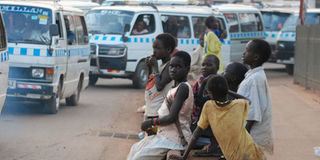Prime
Is Uganda losing its gains on Child welfare?

What you need to know:
Last week, there was a discussion on the gains child welfare has made in the past 20 years. We explore which areas Uganda has made losses, why and how we can improve the gains
Charles Kibirige Tumwebaze’s concept of family is unlike what most of us carry around today.
Abandoned at the Sanyu babies’ home in his infancy, he was later transferred to the SOS Children’s Village. Fast-forward to today, Charles is in the US on a study scholarship he earned with support from the SOS children’s home, from a rural school in Kakiri village, Wakiso District.
“One of the things you learn growing up in a children’s home is that you must appreciate the little you have,” he says.
Kibirige is just but one of a select few that have been lucky to benefit from a welfare system that not only provides for needs such as education, feeding and love but creates opportunities for its children to grow and be prosperous.
“I have been blessed with the education opportunities that have come my way, but I am not yet fulfilled. Most of my brothers and sisters in Uganda do not have such chances,” he modestly adds.
Ideally, every child in Uganda – irrespective of their background – should be accorded the appropriate care to help them grow. However, research shows that currently, a large chunk of children in Uganda still lack the care needs that would create an ideal platform for them to blossom.
The United Nations Children’s Fund (Unicef) together with Uganda Child Rights NGO Network (UCRNN) recently held a symposium to count the gains in child welfare over the past two decades.
The event attracted policy makers, legislators and development partners to deliberate on the child rights journey in Uganda and take stock of the gains.
Oddly, the statistics that were fronted to depict the gains ranged from 1988 to 2011. What happened between then and now is unknown.
Taking an aggregation of research findings released between 2011 and 2014, reveals a nose dive in the plight of millions of Uganda’s youth.
Five years ago, the number of homeless, deprived and deserted children that were taken under the care of SOS children’s villages, for example, was only 400. That has more than tripled over the last five years from (what?) to 5,000 children.
To put that into context, Olive Lumonya, the country director SOS children’s villages, points out several contributing factors to this staggering rise. She asserts that increased poverty, unemployment, and high crime rates, especially relating to children such as child labour, defilement and neglect, are the major causes of this deterioration.
“There are more and more children that are orphans and vulnerable today. However, even with these huge numbers, the different stakeholders charged with child welfare are not stepping up and putting in enough to help the situation,” Lumonya explains.
Education

Children in a classroom. A recent study on children’s welfare shows that 15 per cent of children have never been to school. This is one of the indicators that child welfare in Uganda is still wanting. FILE PHOTO
As of 2011, the national enrolment for children into schools stood at an estimated 800,000 and one million for primary and secondary respectively.
Much as the figures have basically remained the same, the completion rate in the final year of primary or secondary education, regardless of age, at both levels has been declining, falling from 58 per cent in 2013 to 49 per cent in 2014.
The above figures do not take into account the proportion of children who have never attended school that has been increasing significantly especially amongst children from the rural areas.
Statistics released by United Nations Educational, Scientific and Cultural Organisation (Unesco) this year revealed that 700,000 children have no access to school, ranking Uganda 11th in the world with the highest number of children out of school.
A 2014 Unesco numeracy and literacy report shows Uganda as the worst country in East Africa with more children in primary who lack basic reading and counting skills.
“The situation is certainly very disappointing. Many children are out of school today. In many circumstances they go to these schools hopeful that they will acquire a good learning experience but instead find empty classrooms without teachers,” says James Tweheyo, Uganda National Teachers Union (Unatu) General Secretary.
Tweheyo argues that tackling the challenges children are encountering in accessing free and quality education is a matter that can be addressed through policy with all stakeholders playing their roles.
“Today parents with children under the UPE and USE programs think they have no obligation in the care of their children because the perception is government will cover the costs,” he says.
Tweheyo believes government ought to take responsibility and implement its programmes efficiently or better yet, sensitise the parents on their role in the matter.
He argues that so far, service delivery has been poor and blames the education ministry for being bureaucratic.
“For example, it is incredible that this year, UPE and USE grants for term two delayed until there were just two weeks to the end of the term. How are these children supposed to be supported?”
Child safety
Statistics from a 2010 to 2012 Unicef and Uganda Demographic and Health Survey (UDHS) show that 21 per cent of teenage girls have experienced sexual violence and half the population of children are being married off by age 18.
A 2013 police report pushes that figure further, showing a16 per cent increase of defilement cases from the previous year.
“Physical abuse is also increasing. Currently, it is at 84 per cent,” notes Miriam Ahumuza, a publicist at ANPPCAN, whose organisation reported more than 4,000 cases in 2013 ranging from child neglect, sexual abuse, child labour, emotional abuse, physical abuse among others.
To add to that, current Unicef figures show that an additional 25 per cent of children between five and fourteen years are engaged in child labour.
She says the current predicament of children is a direct result of increased poverty and inability by the young to speak out when they are abused and stresses that the rising poverty has played an even larger role.
“Today, most children are suffering in silence since they have few people to talk when they are faced with child abuse. For example if you look at the sexual abuse cases received last year, majority of the perpetuators were relatives and the families decided not to pursue the case so as not to taint their reputation,” she explains.
“As such, children find themselves with no one to pour out their hearts to thus suffering silently.”
She warns that unless handled, the psychological effect this abuse has on the child population may have a negative bearing on the society and also the country’s development sooner than later.
Health
Today, almost half of childbirths in the country still go unattended and a quarter of children in the poorest households have no access to a toilet, according to findings by Save the Children and Unicef.
Prof Jerome Kabakyenga, director of Healthy Child Uganda, an organisation focused in improving child health says there are also multiple cases of poor nutrition (under nutrition, stunting, wasting), communicable diseases (malaria, respiratory tract infections, diarrhoea, HIV) and all these are compounded by poverty.
In 2000, the government of Uganda committed to meeting the global Millennium Development Goals (MDGs) by 2015 and placed particular attention on achieving MDG 5 for maternal health and MDG 4 for child survival.
However, the country is not yet on track for either goal. Research by Unicef indicates that each year, around 141,000 children die before their fifth birthday and 5,000 women die due to complications of pregnancy and childbirth.
Kabakyenga reasons that having functional village health team (VHTs) volunteers could help in mobilising parents and linking communities to health facilities and urges government to allocate a bigger proportion of the budget to the health sector
Kabakyenga believes that short of that, the status quo will be maintained; high mortality rates for children and their mothers and a high population growth rate that is unsustainable from having children married off so young.
What can be done
Lumonya argues that for child welfare to be improved, the stakeholders like government, and parents need to step up and play their role now.
“That way, we can improve the quality of education in schools as well as broaden access to quality health services,” she says.
“However, all that cannot be effected without improving the level of household incomes. So inadvertently, tackling poverty will play a huge role in this.”
Currently, more than half of Uganda’s 33 million population is under the age of 18. It is pertinent to improve the lives of children and youth, especially the most vulnerable and marginalised.
Lumonya stresses that with such a young population – slightly more than half the country’s total population – any milestones to mark in Uganda’s future will depend heavily on ensuring that presently children like Tumwebaze are well taken care of.
THE NUMBERS
1.6 million
The number of children under five who live in extreme poverty
2.2 million
The number of children under five suffer from stunting
15
Percentage of children who have never attended school




